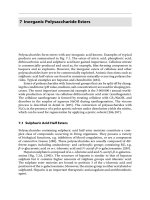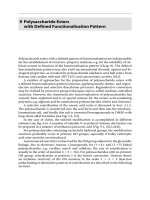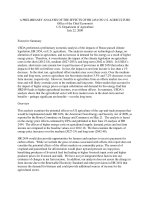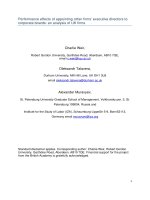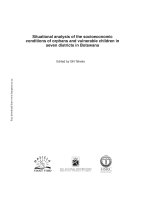STRUCTURE ANALYSIS OF POLYSACCHARIDE ESTERS
Bạn đang xem bản rút gọn của tài liệu. Xem và tải ngay bản đầy đủ của tài liệu tại đây (665.43 KB, 25 trang )
8 Structure Analysis of Polysaccharide Esters
For modified polysaccharides, the analysis goes far beyond the structural verifi-
cation. The chemical structure of the ester function introduced, the DS, and the
distribution of the functional groups at both the level of the RU and along the
polymer backbone (Fig. 8.1) can strongly influence the properties and need to be
determined comprehensively.
Fig. 8.1. Schematic plot of the possible patterns of functionalisation for the repeating units (A)and
for the distribution along the polymer chain (B) of polysaccharides with three reactive sites
144 8 Structure Analysis of Polysaccharide Esters
The chemical functionalisation may be associated with side reactions modify-
ing the polymer backbone additionally, maybe to a rather low extent only. These
“structural impurities” introduced have to be revealed as well because they are not
removable from the polymer chain. Consequently, an efficient and reliable analy-
sis (type of functionalisation, DS, the pattern of substitution) is indispensable for
the establishment of structure–property relations of the modified polymers. The
tailored modification of substitution patterns can be used to “fine tune” product
properties, e.g. solubility behaviour, as shown for the water solubility of cellulose
acetate in Table 8.1 [89].
Table 8.1. Water solubility of cellulose acetate: dependence on the pattern of functionalisation
(adapted from [89])
Method
a
Total DS
b
Degree of acetylation at position
b
Water-solub le fra c t i on
2 3 6 (%, w/w)
1 0.49 0.16 0.13 0.20 29
1 0.66 0.23 0.20 0.23 99
1 0.90 0.31 0.29 0.30 93
2 0.73 0.18 0.19 0.36 30
3 1.10 0.33 0.25 0.52 5
a
Methods applied: (1) deacetylation of cellulose triacetate with aqueous acetic acid, (2)reaction
of cellulose triacetate with hydrazine, and (3) acetylation of cellulose with acetic anhydride in
DMAc/LiCl
b
Determined by
13
CNMRspectroscopy
Analytical data are also necessary to confirm the reproducibility of a synthesis
and the resulting product purity. Unconventional polysaccharide esters, e.g. with
sensitive heterocyclic moieties, can often not be analysed by “standard methods”
and this has required the development of new analytical tools.
Most of the structural features of the polymer backbone are accessible via opti-
calspectroscopy,chromatographyandNMRspectroscopy,asdiscussedinChap.3.
Specific techniques useful to determine the result of an esterification, the DS, and
the pattern of functionalisation are described herein. The evaluation of the pattern
of functionalisation is illustrated in detail for the most important polysaccharide
ester, cellulose acetate. Detailed spectroscopic data for other polysaccharide esters
are given in Chaps. 3 and 5.
From the synthesis chemist’s perspective, the most reliable, powerful and effi-
cient method for the detailed structure elucidation at the molecular level is NMR
spectroscopy. A number of interesting new chromatographic tools have been de-
veloped over the last two decades, with a potential of gaining defined structural
information, but they are combined with a variety of complex functionalisation
steps making them susceptible to analytical errors and, therefore, should be used
only by experienced analysts.
8.2 Optical Spectroscopy 145
8.1 Chemical Characterisation – Standard Methods
Saponification of the ester function in the polysaccharide derivatives with aqueous
NaOH or KOH and back-titration of the excess base is one of the oldest and easiest
methods for the determination of the DS. In the case of short-chain aliphatic
esters (C
2
–C
4
) of glucans, galactans and fructans, it is a fairly accurate method.
For polysaccharide esters containing acidic (COOH) or basic (NH) functions, an
absolute deviation may occur.
For longer aliphatic esters, strong hydrolysis conditions need to be applied
(0.5 N NaOH, heating 48 h at 50
◦
C [372]). Saponification in solution, e.g. in acet-
one, has been used to determine the total acyl content in mixed polysaccharide
esters, e.g. cellulose acetate propionates and acetate butyrates. This procedure
overcomes some of the difficulties encountered in the commonly used heteroge-
neous saponification, in that it is independent of the condition of the samples, can
be run in a shorter elapsed time, and is a little more accurate [373]. Analysis of
polysaccharide esters containing many of the C
2
–C
4
acid esters is carried out by
completely hydrolysing the ester with aqueous alkali, treating with a high-boiling
mineral acid in an amount equivalent to the alkali metal content, distilling the re-
sulting mass to obtain all of the lower fatty acids in the form of a distillate, titrating
a given amount of the distillate with standard alkali, and determining the different
amounts of acids by titration after fractionated extraction [374].
Acid–base titration is an approach to evaluate ester cross-linking of polysac-
charides with polycarboxylic acids such as 1,2,3,4-butanetetracarboxylic acid, by
measuring the concentrations of ester and free carboxylic acid using calcium acet-
ate back-titration [375, 376].
In the case of polysaccharide dicarboxylates and esters with hydroxy polycar-
boxylic acids, i.e. citric acid, malic acid or tartaric acid, potentiometric titration
is used [377, 378]. Unsaturated esters such as starch acrylic acid esters have been
characterised via the bromide/bromate method or with permanganometric titra-
tion [379].
For esters containing heteroatoms, a convenient method is elemental analysis.
The DS is calculated by Eq. (8.1).
DS
=
%Analyte· M
r
(RU) − 100 · a · M
r
(RU)
100 · b · M
r
(Analyte) · M
r
(Introduced mass)
(8.1)
%Analyte (e.g. heteroatom) obtained by elemental analysis
a
=
number of analyte in the repeating unit
b
=
number of analyte in the introduced group
M
r
(RU)
=
the molar mass of the repeating unit
8.2 Optical Spectroscopy
In addition to the characteristic signals for the polysaccharides given in Table 3.2,
the strong C
=
O stretch band at 1740–1750 cm
−1
is characteristic of an ester moiety.
146 8 Structure Analysis of Polysaccharide Esters
For unsaturated esters, the signal is shifted to lower wave numbers (about 20 cm
−1
)
and, in esters with strong electron withdrawing groups, e.g. trifluoroacetates, is in
the region of 1760–1790 cm
−1
[188].
IR spectroscopy has been used for a quantitative evaluation of the amount of
bound carboxylic acid and the distribution of the primary and secondary hydroxyl
groups. It is a valuable tool for low-substituted derivatives and has been used to
estimate the DS. Consequently, it is applied for the analysis of low-substituted
starch acetates, showing good reproducibility [380]. Moreover, the FTIR bands
assigned to sodium acetate produced by saponification of starch acetate can be
detected by means of the ATR method, which can be used to determine the DS,
showing a good correlation with values obtained from NMR [381].
In IR spectra of highly substituted cellulose acetates and mixed esters (0.15–
3.0% solution in methylene chloride), two signals at 1752 and 1740 cm
−1
are ob-
served, corresponding to acyl moieties at positions 2 and 3 and at position 6
respectively (Fig. 8.2). The signal areas can be used for the calculation of the ratio
of substitution at the different reactive sites.
Fig. 8.2. The C=O signal region of an IR spectrum
(0.15–3.0% solution in methylene chloride, meas-
ured in a KBr cell) of highly substituted cellulose
acetates (1, C=O signal at positions 2 and 3, 2, C=O
signal at position 6, adapted from [383])
The wave number is not influenced by the length of the chain in aliphatic acid
esters, as shown in Fig. 8.3, and thus the technique can be extended to mixed esters.
Comparable information concerning the distribution of substituents is acces-
sible by evaluation of the signal region of the OH groups (Fig. 8.4).
A signal at 3660 cm
−1
corresponds to the primary OH unit. Furthermore,
signals at 3520 and 3460 cm
−1
are caused by secondary hydroxyl moieties. The
absorption at 3580 cm
−1
can be attributed to hydrogen bonding of the primary
hydroxyl group [382, 383]. Line shape analysis or deconvolution of the spectra is
helpful, and can be carried out with many modern FTIR instruments.
In addition to IR spectroscopy, Raman and NIR spectroscopy are frequently
utilised for the investigation of polysaccharide esters. The potential of these two
methods is discussed in [384]. DS determination for a number of cellulose deriva-
tives, including tosyl cellulose and cellulose phthalate, has been carried out after
calibration with standard samples of defined DS. It has been shown that confo-
8.2 Optical Spectroscopy 147
Fig. 8.3. FTIR spectra of aliphatic acid esters of
cellulose with different numbers of carbons in
the range C
5
–C
18
(reproduced with permission
from [95], copyright Wiley VCH)
Fig. 8.4. IR spectrum (0.15–3.0% solu-
tion in methylene chloride, measured in
aKBrcell)ofcellulose acetates(OHgroup
region, 1, primary OH, 2, hydrogen bond
of primary OH group, 3 and 4, secondary
OH functions, adapted from [382])
cal Raman spectroscopy is a very valuable method to study surface properties of
such derivatives. Additionally, remote Raman sensing is a valuable tool for the
determination of kinetic and chemical engineering data of esterification reactions,
which are obtained in a direct and non-invasive inline manner by using remote
Raman sensors. This is illustrated by the synthesis of cellulose acetate and cellulose
phthalate. In Fig. 8.5, the development of Raman spectra versus time is shown for
a reaction mixture consisting of cellulose dissolved in DMAc/LiCl and phthalic an-
hydride at 70
◦
C over 10 h. The disappearance of signals for the anhydride at 1760,
1800 and 1840 cm
−1
is visible on the one hand. On the other hand, the development
of a signal for the phthalate at 1720 cm
−1
is observed.
148 8 Structure Analysis of Polysaccharide Esters
Fig. 8.5. The development of the Raman spectra versus time for a reaction mixture consisting of
cellulose dissolved in DMAc/LiCl and phthalic anhydride at 70 °Cover10 h(reproducedwith permission
from [384], copyright ZELLCHEMING)
For the DS determination of maleinated starch by means of Raman spec-
troscopy, the calibration sets have very high linearity (r>0.99). Combined with
simple sample preparation, Raman spectroscopy is a convenient and safe method
for the DS determination of polysaccharide esters [385].
UV/Vis spectroscopy is usually applied after ester hydrolysis. For calibration,
standard mixtures of the polysaccharide and the acid are prepared and measure-
ments at the absorption maximum of the acid are performed. DS determination
is easily achieved by UV/Vis spectroscopy on mixtures of the saponified polysac-
charide esters, e.g. for bile acid esters of dextran. The ester is dissolved in 60%
aqueous acetic acid and a mixture of water/sulphuric acid (13/10, v/v) is added.
The mixture is treated at 70
◦
C for 30 min and measured (after cooling) at 378 nm
to obtain the amount of covalently bound bile acid [216, 217]. A similar technique
is applied for the analysis of the phthaloyl content of cellulose phthalate after
saponification [386] and for polycarboxylic acid esters, e.g. starch citrate [387].
An interesting and simple approach to determine the DS of starch esters with
UV/Vis spectroscopy is the investigation of the iodine-starch ester complex. The
effect of acetylation on the formation of the complex has been studied by mon-
itoring the decrease in absorbance at 680 nm (blue value), which decreases by
increasing the DS [381].
8.3 NMR Measurements 149
8.3 NMR Measurements
The application of NMR techniques was among the first attempts for the structure
analysis of polysaccharide esters that exceeds the simple DS determination. The
pioneering work of both Goodlett et al. in 1971 [388] using
1
H NMR spectroscopy,
and of Kamide and Okajima in 1981 [389] applying
13
C NMR measurements on
cellulose acetates opened major routes for further studies in this field, including
complete signal assignment, the determination of the functionalisation pattern
of polysaccharide esters depending on reaction conditions, and the establishment
of structure–property relationships. Description of the sample preparation and
representative signals of the polymer backbones are given in Sect. 3.2. NMR exper-
iments on polysaccharide derivatives are most commonly performed in solution
state. The solubility of the derivatives strongly depends on the DS and the type of
polymer. Thus, a selection of NMR solvents used for the spectroscopy of polysac-
charide esters is listed in Table 8.2. The preferred solvent for the investigation
Table 8.2. Typical NMR solvents used for the solution state
13
C- and
1
H NMR spectroscopy of poly-
saccharide esters
Name
1
Hshift
1
Hshift
13
C shift Boiling point
(multiplicity) of water (multiplicity) (°C)
Acetone-d
6
2.04 (5) 2.7 29.8 (7) 57
260.0 (1)
Acetonitrile-d
3
1.93 (5) 2.1 1.3 (7) 82
118.2 (1)
CDCl
3
7.24 (1) 1.5 77.0 (3) 62
D
2
O 4.65 (1) 101.4
DMF-d
7
2.74 (5) 3.4 30.1 (7) 153
2.91 (5) 35.2 (7)
8.01 (1) 162.7 (3)
DMSO-d
6
2.49 (5) 3.4 39.5 (7) 189
CD
2
Cl
2
5.32 (3) 1.4 53.8 (5) 40
Py-d
5
7.19 (1) 4.9 123.5 (5) 116
7.55 (1) 135.5 (3)
8.71 (1) 149.9 (3)
THF-d
8
1.73 (1) 2.4 25.3 (1) 66
3.58 (1) 67.4 (5)
Tolu ene- d
8
2.09 (5) – 20.4 (7) 111
6.98 (m) 125.2 (3)
7.00 (1) 128.0 (3)
7.09 (m) 128.9 (3)
137.5 (1)
TFA-d
1
11.5 (1) – 116.6 (4) 72
164.2 (4)
150 8 Structure Analysis of Polysaccharide Esters
of partially substituted esters is DMSO-d
6
, which dissolves the polymers within
a wide range of DS values and is comparably inexpensive.
The application of
13
C NMR spectroscopy with focus on cellulose esters has
been reviewed [63]. For the majority of (1→4) linked polysaccharides, e.g. starch
and cellulose, esterification of the primary OH group results in a downfield shift
(higher ppm values, between 2–8 ppm) of the signal for the adjacent carbon.
In contrast, the signal of a glycosidic C-atom neighbouring carbon adjacent to
an esterified OH moiety shows a high-field shift in the range of 1–4 ppm.The
signal splitting and the corresponding shifts of the other carbon atoms of the
polysaccharides strongly depend on the electronic structure of the ester moiety
bound. This is illustrated for cellulose sulphuric acid half ester and cellulose acetate
in Fig. 8.6. A complete assignment requires two-dimensional NMR techniques.
In the spectra of partially functionalised derivatives, a mix of spectra is ob-
served (Fig. 8.6). In combination with the line broadening caused by different
patterns of substitution, the spectra obtained are very complex. Nevertheless, the
signal splitting and the intensities of the carbon atoms of the glycosidic linkage
give an insight into the degree of functionalisation at the neighbouring positions.
Fig. 8.6. Schematic
13
C NMR spectra of cellulose (spectrum in the middle) and completely sulphated
(lower picture) as well as fully acetylated cellulose (upper picture) and the characteristic shifts caused
by the esterification
8.3 NMR Measurements 151
The structure elucidation of organic esters of polysaccharides can be well
illustrated with cellulose acetates, and the techniques can be similarly applied for
other polysaccharide esters. Table 8.3 shows representative
13
C NMR spectroscopic
data of cellulose triacetate.
Table 8.3. Chemical shifts of the
13
C NMR signals for cellulose triacetate (adapted from [390])
δ
(ppm)
a
DMSO-d
6
CDCl
3
90
◦
C 25
◦
C
C-1 99.8 100.4
C-2 72.2 71.7
C-3 72.9 72.5
C-4 76.4 76.0
b
C-5 72.5 72.7
C-6 62.8 61.9
a
Relative to CDCl
3
at 77.0 ppm or DMSO-d
6
at 35.9 ppm
b
The coupled resonance overlaps with the solvent resonance
The assignment of the signals is based on the comparison of chemical shifts
of model compounds such as peracetylated cellobiose, cellotetraose, cellopentaose
and cellulose [391–393]. Data are available for the peracetylated homoglucanes
pullulan [102] and dextran [58], i.e. the pullulan nonaacetate with its maltotriose
structure of the polymer backbone (Table 8.4).
As described above,
13
C NMR spectra of cellulose acetates provide structural
characterisation and determination of both total DS and the distribution of acetyl
functions within the RU concerning positions 2, 3 and 6 in partially functionalised
polymers [394, 395]. The investigation of cellulose acetate samples with DS values
of 1.7, 2.4 and 2.9 reveals the same NOE for C-1–C-6, which confirms quantitative
assessment of partial DS values at positions 2, 3 and 6 from the
13
C NMR spectrum.
The signals at 59.0 ppm (C-6 unsubstituted), 62.0 ppm (C-6 substituted), 79.6 ppm
(C-4, no substitution at C-3), 75.4 ppm (C-4 adjacent to substituted position 3),
101.9 ppm (C-1, no substitution at C-2) and 98.9 ppm (C-1 adjacent to substituted
position 2) are used for the calculation.
The exact distribution of substituents in polysaccharide esters over a wide
range of DS is not readily estimated by simple comparison of the relevant peak
152 8 Structure Analysis of Polysaccharide Esters
intensities. A major problem is the overlapping of signals at around 70–85 ppm,
resulting from the unmodified C-2–C-5 and the corresponding acylated positions
2and3aswellastheinfluenceofanacylatedposition3onthechemicalshiftofC-4.
In addition, line broadening of the signals due to the ring carbons is frequently
observed in the quantitative mode of
13
C NMR measurements. The fairly long
pulse repetition time applied causes T
2
relaxation of the relevant signals.
Table 8.4. Assignment of the carbon signals in pullulan peracetate in ppm (position, see Fig. 2.4,
adapted from [102])
Position Chemical shift (ppm)
Maltotriose C
=
O
A1 95.62 –
A2 70.58 170.72
A3 71.89 169.64
A4 72.76 –
A5 69.00 –
A6 62.84 170.32
B1 95.99 –
B2 71.32 170.45
B3 72.30 169.42
B4 73.88 –
B5 69.77 –
B6 63.10 170.34
C1 95.60 –
C2 70.10 170.52
C3 69.79 169.85
C4 68.39 169.02
C5 68.03 –
C6 64.80 –
Several authors have concentrated on assigning the signals of the C
=
O of the
acetyl moieties [396]. Acetyl methyl and C
=
O signals appear as overlapped mul-
tipeaks, reflecting the detailed substitution pattern with regard to the 8 different
RU as well as the hydrogen bond system of cellulose acetate with DS < 3. A prelim-
inary assignment of the C
=
O signals of cellulose acetate is achieved by applying
a low-power selective decoupling method to the methyl carbon atoms of the acetyl
groups [397], and can be carried out via C-H COSY spectra of cellulose triacetate
(Table 8.5, [398]).
An elegant analysis of the structure elucidation of cellulose [1-
13
C] acetates
prepared in different ways with a wide range of DS values is described by Buchanan
et al. [399]. A total of 16 carbonyl carbon resonances can be identified using
a variety of NMR techniques, including INAPT spectroscopy. The assignment
differs somewhat from that given in Table 8.5. In the case of C-2 and C-3 carbonyl

